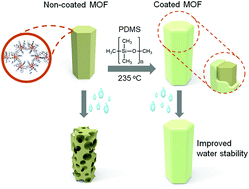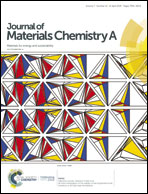A diamine-grafted metal–organic framework with outstanding CO2 capture properties and a facile coating approach for imparting exceptional moisture stability†
Abstract
Prospective solid adsorbents for CO2 capture require low total regeneration energy that can be achieved by combining high working capacity, a low desorption temperature, and a narrow temperature difference (ΔT) between capture and regeneration. These materials should be critically water-stable because flue gas from coal-fired power plants contains water vapor. Herein, we present the development of a diamine-appended metal–organic framework (MOF) adsorbent that showed unprecedented performance with a record narrow ΔT (30 °C), a quite low regeneration temperature (≤100 °C), and a significant working capacity (14 wt%) over 600 cycles. Remarkably, coating of the MOF with polydimethylsiloxane (PDMS) imparted enhanced moisture stability and superior CO2 adsorption capacity. Such a simple coating approach can be used to design humidity-stable MOF adsorbents, with exceptional performance, applicable in real-world CO2 capture processes.



 Please wait while we load your content...
Please wait while we load your content...